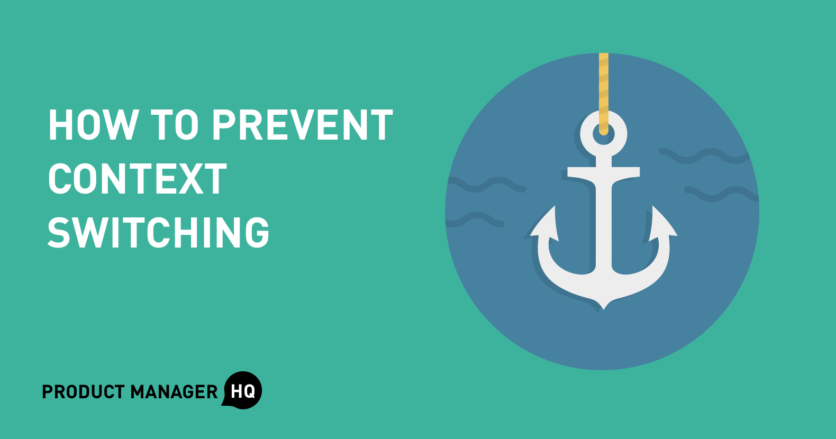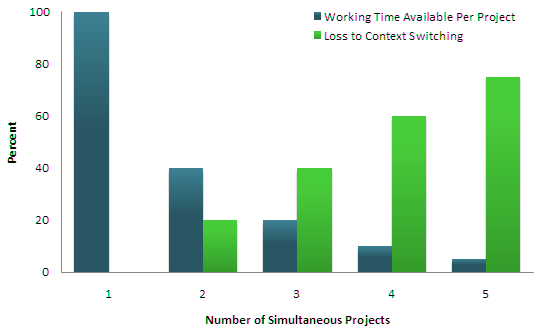Since product managers fill the white space between departments and have so many tasks to juggle, we’re constantly switching between different contexts.
For example, one moment we’ll be writing up a meeting agenda, and the next minute we’ll be dropped into an urgent bug resolution war room.
Context switching usually causes major losses. I’ll present some research below that demonstrates the high negative impact of context switching.
Yet, at the same time, product managers don’t usually have the luxury of working with uninterrupted time, specifically because we have so many responsibilities and fill up the white space.
Therefore, we’ll explore context switching in two articles.
In this first article, I’ll walk through the costs of context switching, and I’ll share conventional advice on how to prevent context switching.
In our second article, I’ll provide best practices on how to context switch more effectively, in the highly likely scenario where you’re unable to prevent it from happening.
So let’s talk about why context switching is incredibly costly, and what you can do to prevent it.
Costs of Context Switching
Research has demonstrated that switching contexts imposes major costs on people’s productivity and effectiveness.
For example, the American Psychological Association has compiled multiple studies on context switching. One study demonstrated that participants lose time for all tasks when switching between multiple tasks, and that they lost the most time when switching between complex tasks.
The Trello blog states that the cost of lost productivity due to multitasking is $450 billion. This economic loss is due to the fact that it takes an average of 25 minutes to resume a task after being interrupted, and that multitasking temporarily reduces mental performance.
The Sprk’d blog has this handy chart below that demonstrates that for each additional project taken on simultaneously, people lose larger and larger proportions of productive time.
This lovely comic by Jason Heeris demonstrates what happens when you interrupt a programmer – which is easily applicable to what happens when you interrupt a product manager as well.
Based on research, anecdotes, and experiences, it’s pretty clear that context switching is highly detrimental to productivity.
So, let’s talk about the ideal – how you can prevent context switching from happening in the first place.
How to Prevent Context Switching
Most advice states that we should actively design our days so that we have uninterrupted time to focus.
The most productive people are not the people who have the willpower to force themselves to focus, but rather those who are not subjected to context switching by their environment.
On the surface, this advice may feel unactionable. After all, we’re surrounding by distractions: we have to pay attention to emails, to our work chats, to our phones, and to colleagues who might come to us.
Yet, study after study shows that productivity and achievement come from avoiding distraction and temptation.
In a popular blog post by Benjamin Hardy, the author states the following: “the best use of your choices is consciously designing environments that facilitate your commitments.”
The Trello productivity blog provides the following advice: “if you find you’re constantly getting pulled away from your work by text messages, turn your phone notifications off while you’re doing deep work; that way, you eliminate all the unnecessary decisions that go along with your text habit (like whether to stop working and look at the text, whether to answer, or whether to continue the conversation) and can put that energy into actually getting work done.”
Rather than considering how to minimize context switching at a task-by-task level, consider the following tactics to minimize context switching overall.
1) Consolidate your recurring meeting times together, away from your deep work time. Asana and other tech companies have implemented No Meeting Wednesdays, as a forcing function to encourage everyone to consolidate meetings.
After all, you’ll be much more productive if you have a solid block of 4 hours to work, rather than having scattered meetings throughout the day, since every meeting forces you to context switch.
2) Determine your response schedule. You don’t need to respond to your chat or emails in real time.
Think about the true impact of your response times – very few initiatives will fail just because you took 1 hour to respond instead of 1 minute.
This advice can feel counterintuitive. Most of us secretly enjoy responding to emails because it makes us feel productive.
However, each time you respond, you context switch from your active task. Emotions can be deceptive – you might feel productive, but you may not actually be productive!
Put times on your calendar to explicitly respond to emails and chat, then turn off your phone and close your email and chat apps until it’s time to respond.
I can honestly tell you that the first time I tried doing so, I had a lot of anxiety. What if I miss something important?
But, after sticking to explicit response schedules for about a month, I found that my anxiety was replaced with deep satisfaction instead. It’s scary, but it’s worth it.
Plus, if something really is incredibly urgent and you happen to miss it, someone will find you in person!
3) Schedule office hours. Provide your colleagues with clear rules of engagement, and examples of what sorts of questions to ask during office hours.
This advice is especially relevant for product managers who work on highly visible products, or products with high adoption.
By creating a set time for colleagues to approach you with questions, you reduce the likelihood of someone reaching out while you’re in the middle of something else.
Most people do exercise common sense when reaching out. Unless it’s urgent, informed stakeholders generally will hold their questions until your recurring discussion time.
4) Block out times for deep focus.
This tactic is especially relevant for high-leverage situations, such as determining the product strategy for the rest of the year.
Schedule a meeting with yourself on your calendar, and book a room for this time. In looking across calendars, I’ve seen these “focus meetings” range anywhere from 2 hours to 4 hours, depending on the magnitude of the task ahead.
Inform your teammates and colleagues that you are not to be disturbed during this critical period of time, and share with them why you need to focus.
Reschedule or decline any meetings that conflict with your focus meeting.
By doing so, you guarantee that you’ll be able to tackle what’s truly important, rather than tackling urgent but noncritical work.
5) Prioritize ruthlessly and decline low priority commitments.
Don’t attend meetings if agendas aren’t clear. Don’t fill the white space if it won’t move the needle. Say no to the things that don’t matter.
One way to prioritize is by using the Eisenhower box, which classifies tasks by importance and urgency, then recommends actions based on these classifications.
Remember – part of product management is deciding “which decisions are actually the most important?” Prioritization is key to delivering impact! The fewer open commitments you have, the less likely you will need to context switch.
Summary
Context switching is highly expensive – it reduces productivity and effectiveness. This fact rings especially true for product managers, as we can only make the best decision by deeply understanding the context behind the decision.
One of the best ways to deal with context switching is to design your schedule so that you avoid context switching.
To do so, try the following tactics: consolidate your meeting times, determine your response schedule, schedule office hours, block out focus time, and prioritize ruthlessly.
Of course, since product managers fill the white space, we don’t always have the capability or luxury of redesigning our schedule to fully prevent context switching.
Therefore, in our next article, we’ll discuss how to optimize for context switching.
Have thoughts that you’d like to contribute around how to prevent context switching? Chat with other product managers around the world in our PMHQ Community!
Join 30,000+ Product People and Get a Free Copy of The PM Handbook and our Weekly Product Reads Newsletter
Subscribe to get:
- A free copy of the PM Handbook (60-page handbook featuring in-depth interviews with product managers at Google, Facebook, Twitter, and more)
- Weekly Product Reads (curated newsletter of weekly top product reads)
Clement Kao has published 60+ product management best practice articles at Product Manager HQ (PMHQ). Furthermore, he provides product management advice within the PMHQ Slack community, which serves 8,000+ members. Clement also curates the weekly PMHQ newsletter, serving 27,000+ subscribers.



